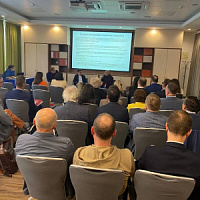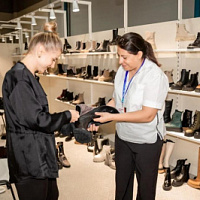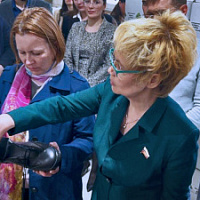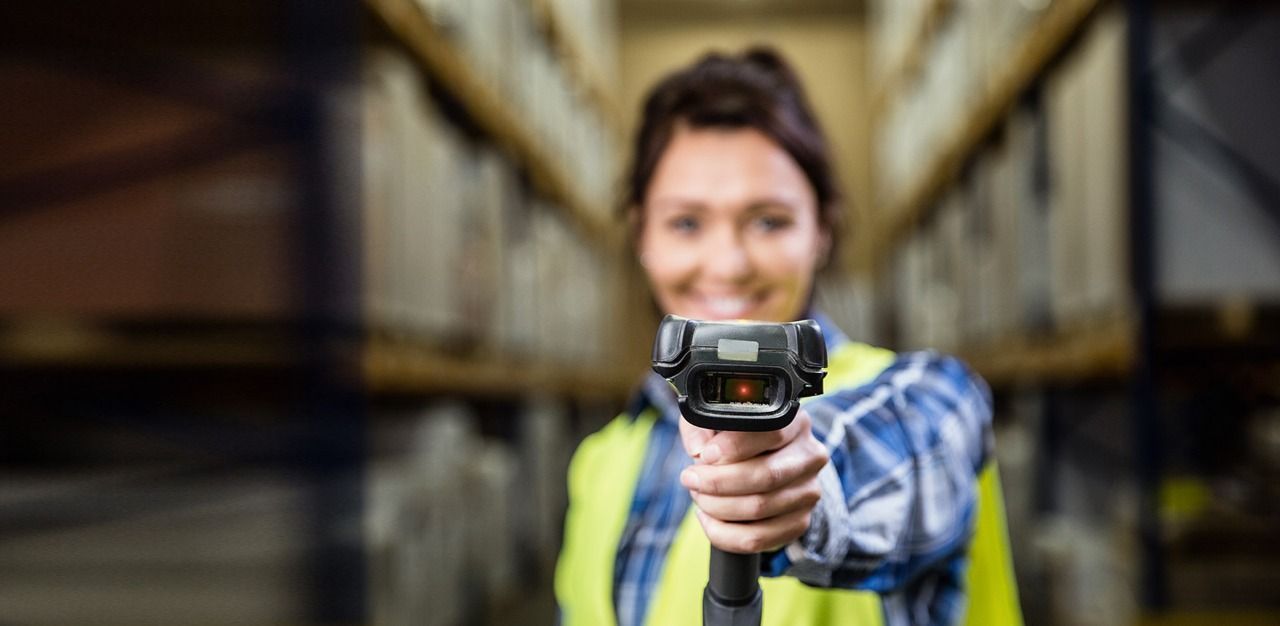
The practice of marking shoes. Software solutions

Alfasens has developed a unique software solution on the 1С platform, which, coupled with a mobile application, allows marking shoes in the framework of the system implemented by the operator of the central distribution center today. What is the uniqueness of this solution and its importance for market participants says the company's commercial director Olga Markina.
 Olga Markina - Commercial Director of Alfasens
Olga Markina - Commercial Director of Alfasens1 July 2019 year in Russia launched a project for digital labeling of shoes. According to the Decree of the Government of the Russian Federation No. 5 of July 2019 of July 860, the “Rules for the labeling of shoe goods” were approved, which were the first official document that regulates in detail the process of marking shoes for market participants. Prior to this, there were the MDGT Methodological Recommendations developed in the bowels of the labeling operator with the participation of the Shoe Union working group (NOBS WG), and also a lot of technical documents and instructions governing data exchange and interaction with the MDGs. “Rules” provide detailed information on the composition of market participants and their requirements, regulate the procedure for their registration in the GIS MT and the procedure for information exchange with the GIS MT. They also describe the procedure for registering shoe goods in the GIS MT, describe the labeling code, the aggregation code and the aggregated customs code (ATC) for the FCS, as well as their composition and the procedure for their formation. In addition, the Rules establish the procedure for applying marking codes, the procedure for exchanging data with MT GIS, including the withdrawal of marking codes from circulation, as well as the procedure for amending the information contained in MT GIS.
Of course, this document is extremely important for the market and eliminates a lot of speculation and rumor, which was enveloped in digital marking. However, at the same time, there remained a lot of questions that market participants often ask at all kinds of conferences, and even project participants from the very beginning sometimes find it difficult to give clear answers to these questions. In my opinion, one of the pressing issues is not a theoretical one, but the most practical one, namely - does the MDTC provide tools for working with marking and what kind of tools it is. We are talking about software solutions ("software"), but not only. In addition to software solutions, it is equally important to have tools for working with marking codes in factories, warehouses and stores, specifically data collection terminals (common scanners) and mobile applications for them. All this, the labeling operator does not provide, but sends to its website, which lists the MDG partners and lists of tested solutions. Let me say that if the first list is difficult to have a claim, the second list looks at least strange. I personally know some of the so-called “tested solutions” and I can assure that the fact of “testing”, unfortunately, does not mean that they can be used here and now. However, it is worth noting that the developers themselves are not always guilty of this - the MDCT has not yet completed the formation of all business processes in its own system (GIS MT). Of course, it is easy to criticize, and it is much more difficult to establish a marking system nationwide. Nevertheless, it remains unclear why then it was necessary to announce the start of shoe marking in Russia, if the system was still very far from debugging. For example, only in June a new release of the system was released, in which, finally, the functionality for entering marking codes into circulation began to work. Until now, although it has been implemented, it is not widely used by market participants to transfer marking codes from seller to buyer. The same applies to the withdrawal of marking codes from circulation, returns, adjustments and much more ...
Of particular note is the expected labeling of residues by all. In general, the mechanism is understandable, but there are still no regulatory acts. There are also no answers to a number of questions, for example, on the format of the code, time limits, number limits and requirements for documents for balances, although according to the results of the discussion in the NLB WG there is a certain understanding in these issues.
All this makes it impossible to create complete and complete software solutions for marking shoes. The leader in creating ERP systems in Russia, the company 1С, has also not yet implemented a marking unit. A new release is expected at the end of September, but there is great doubt that 1C software solutions can be immediately integrated into existing systems. The problem is that the 1С solution will most likely be standard, that is, it will implement some averaged and simplest labeling algorithms. Most likely, this solution will suit market participants with small volumes, for example, shops. However, the market in Russia is represented not only by stores.
Consider, for example, a typical importer, a company importing from 50 to 200 thousand pairs a season from China. First of all, the labeling software solution should be adapted to the business processes of our importer in China. A company may have 2-3 partner factories, or it may have 100 factories. In the first case, it makes sense to send goods directly from a Chinese factory to the Russian Federation, in the second - through a consolidation warehouse. These are different business processes - different ways of applying codes (inside the label and outside the label), different ways of generating reports by scanning data collection terminals (TSD), since it is obviously expensive to buy 100 TSD with a pre-installed mobile application, not to mention the learning process of these factories in the procedure scan. Factories in China are very different - from modern workshops with marble floors to a dedicated piece of land under a canopy from rain and the scorching sun. It should also be noted that 1С only provides the ability to connect the TSD, but the software product itself is missing. Further, in the Russian Federation we see the same problems - accounting of codes, scanning should be “understandable” to the typical 1С system. I repeat, this is possible only for small market participants using standard solutions. All other companies that have implemented numerous developments in their systems, having their own configurations and directories, will be forced to somehow modify the existing release (if they dare to install it) on their own, if they have the staff of 1-programmers, or by third-party organizations accredited company 1С.
Considering that keeping records of marking codes in Excel will not work, at least because of the lack of integration with GS1 and MT GIS, as well as for a number of other reasons, the following dilemma arises for market participants:
- or they find and buy existing software to solve their problems;
- or they outsource the labeling of their products.
Both ways are “workers”, but both are fraught with a number of pitfalls. Let's take a closer look.
Currently, more and more companies are appearing on the market, offering software solutions for “turnkey marking” and claiming that their software really works and allows you to do everything that is provided for by marking. This, of course, is not true for the reasons stated above. The maximum that an IT company can offer to the market in terms of labeling is a software solution that implements everything that is currently implemented in the GIS MT and described in the standard documents of the MDCT, first of all, integration with the GIS MT. The main problem here is the possible isolation of the solution from real life. Imagine a programming specialist. He doesn’t know how the processes of production, purchase and sale of shoes occur. And simple consultations of those who know may not help here, simply because it is better to see once than hear a hundred times. Most likely, no IT specialist in the field of development of software solutions for marking shoes has not seen a Chinese factory and, therefore, will not be able to assess, for example, the likelihood of errors when scanning labeling codes by a packer in a factory. The simple question is whether the packer is a higher paid worker or less paid in comparison with the conveyor workers, confuses even experienced shoe makers. But the question is far from idle - the choice of a method of compiling a shipment report may depend on the degree of qualification of the packer! Another question is whether it is possible to replace the scanning of marking codes with photographing them. And if you simply rewrite the codes for marking boxes in the format “article + box number”? All these are not as simple questions as it seems, and an attempt to answer them without practical knowledge in this area can lead to serious miscalculations.
In my opinion, a prerequisite for creating software is the cooperation of the developer company with a specific shoe company, while the cooperation is not in the form of a “question-answer”, but a real immersion of at least one IT specialist in all the details of the shoe business. But this may not be enough, since one company has business processes organized in one way, and another - in another. An example - different ways of applying marking codes in factories. In some companies it is more convenient to apply them by scanning the GTIN and printing the marking codes in place using a mobile printer and immediately putting them on the boxes with the goods. For others, it can be printing labels with a marking code inside and applying it to shoes on a conveyor, followed by scanning, generating an aggregation code and drawing up a report. Thirdly, it can be the formation of a database of marking codes with aggregation codes in advance so that before closing the box with the pairs of shoes with labels placed in advance according to the “size”, the packer at the factory is given a sheet of A4 format with marking codes separately from the labels. In this case, the packer is left to unstick the desired marking code according to size and stick it on the box of the appropriate size in the box. Scanning in order to generate an aggregation code is not required in this case.
All these are concrete examples, confirming the need for the closest cooperation of a company that claims to create a software solution with a company that is the final consumer of such a software solution. Our company Alphasens (Alphasens Marking Solutions) combines the achievements of several companies - participants of the pilot labeling project and the experience in creating software solutions for companies accredited by 1С. The result of such cooperation was a unique software solution on the 1С platform, which, together with a mobile application, allows marking shoes now in the volume that is currently implemented by the MDCS itself (see above). Description of this software solution is presented on our website. . I will add that this is not an experimental, but a real-life solution, implemented in two versions, local and cloud. Both options are already being actively tested by the shoe market participants. Of course, software solutions are accompanied by their installation with the departure of our specialists (or remotely) and subsequent technical support, including online support.
And yet it seems to me that outsourcing of shoe products will be in great demand. What is the reason for this? First of all, with the difficulties of work leading to increased costs. Alfasens cloud-based software solution is inexpensive, from 5 to 10 thousand rubles per month of a monthly fee, but no program can work by itself. At a minimum, she needs an operator. Further, the importer needs someone who will coordinate the work of the customs department with the program (creating an aggregated customs code (ATC), entering marking codes into circulation), someone who will be involved in accounting for the goods shipped and the work of EDI. A wholesaler needs someone who can handle the flow of invoices. It’s easier for stores, they can get by scanning the goods at the reception, the rest will be done for them by an online cash register with new functionality. Nevertheless, it is clear that the installation of the program is indispensable and the larger the volumes, the more staff will be involved exclusively in this area of the company’s activities.
Alfasens thought about this and formed a proposal for the market for labeling services. Labeling consists of numerous subprocesses, and service packages can be added as a puzzle, choosing only what a specific company needs at the moment. For stores, for example, there is a minimum package that includes entering information into the MT GIS and marking the residues. For importers and / or manufacturers this can be a complete turnkey package, which implies the transfer of an electronic digital signature (EDS) from the customer to the contractor, after which the customer can only control the marking processes at his discretion. The customer forms an individual package independently, choosing the services he needs. The only inconvenience of this system may be related to database security, but this inconvenience is easily overcome by drawing up an appropriate confidentiality agreement with appropriate sanctions.
Labeling services are inseparable from logistics, therefore a logistics service is also included in the package. However, it should be noted that logistics is not a core business of Alfasens, so labeling can be ordered separately. This does not mean inflated prices for logistics, but it takes into account that many companies already have delivery through their counterparties and, most importantly, their importers. Alfasens takes this into account and is ready to work with the importer of the customer. As already noted, for this it is enough for the customer to transfer his digital signature to the contractor. In the case of delivery to the importer of Alfasens, this is not necessary, the company will do everything for the customer.
In conclusion, I want to note that an important condition for choosing a partner in the market for labeling services is undoubtedly experience in the market and experience in providing these same services. Alfasens was established in 2011. Our partners are existing shoe companies, participants in the pilot project from the very beginning. This is a guarantee that our experience is definitely no less than anyone else, and this despite the fact that a huge number of participants in the shoe market do not understand where to start. It seems to us that in addition to the business as such, we also help small companies enter the labeling at a minimal cost. I personally know store owners who don’t understand how to work in the new conditions and are seriously considering options for reducing or even closing a business. There may be different points of view on the economic model in Russia, there are supporters of state monopoly stuck in the USSR, and there are those who sincerely believe that the main business in Russia is oil, gas and weapons, and the rest, if they close, is not a big deal. . Fortunately, the President’s economic team is as strong as ever and does not share these sentiments. We also believe that China, France, Germany and other economically successful countries with strong small and medium-sized businesses, of course, signal us that such a business must be supported by all means. This is what we think of when we put ourselves in the place of a conditional store owner trying to understand how he works with labeling, and we have solutions for him that we will gladly share with him!
| Please rate the article |
Materials on the topic

Results of the round table of shoemakers with the Ministry of Industry and Trade of the Russian Federation, CRPT, NOBS and Wildberries

World Footwear Yearbook: Global footwear production reaches 23,9 billion pairs and is back to pre-pandemic levels

How to double the sales of a shoe store?

New direction of exhibitions in Alma-Ata: Euro Shoes @ Elite Line & CAF

Round table with representatives of shoe factories of Dagestan with the support of the Ministry of Industry and Trade and NOBS
Popular
 Louis Vuitton opens a new factory in Italy
Louis Vuitton has opened its second shoe factory in Italy. After opening the first one in Fiesso d'Artico in Veneto, the LVMH flagship brand has just opened a new production site dedicated to this category of footwear in the industrial zone of Civitano in the Marche region. There is also another brand production facility in Tuscany, where bags and leather accessories are produced, writes fr.fashionnetwork.com.
Louis Vuitton opens a new factory in Italy
Louis Vuitton has opened its second shoe factory in Italy. After opening the first one in Fiesso d'Artico in Veneto, the LVMH flagship brand has just opened a new production site dedicated to this category of footwear in the industrial zone of Civitano in the Marche region. There is also another brand production facility in Tuscany, where bags and leather accessories are produced, writes fr.fashionnetwork.com.
 American buyers couldn't buy Birkin bags and sued Hermès
French fashion house Hermès is facing a lawsuit in California from two customers who were unable to purchase exclusive Birkin bags. The fashion house is accused of unfair commercial practices.
American buyers couldn't buy Birkin bags and sued Hermès
French fashion house Hermès is facing a lawsuit in California from two customers who were unable to purchase exclusive Birkin bags. The fashion house is accused of unfair commercial practices.
 We are ready for active development in the Russian market
Friedrich Naumann, CEO of the Tamaris brand, told Shoes Report about the company’s ambitious plans, business development in Russia and expansion of the retail network, and also shared details about new collections and launches.
We are ready for active development in the Russian market
Friedrich Naumann, CEO of the Tamaris brand, told Shoes Report about the company’s ambitious plans, business development in Russia and expansion of the retail network, and also shared details about new collections and launches.
 “Discount for repairs” of clothes and shoes in France supported workshops
The French have calculated the benefits of a program that encourages consumers to repair clothes and shoes by providing discounts on these services in certified workshops. The “repair discount” program began operating in France in November last year. Over the six months of operation of this program, the number of calls to repair shops in France increased 10 times and amounted to 250 repairs. The French saved 000 million euros, writes leparisien.fr.
“Discount for repairs” of clothes and shoes in France supported workshops
The French have calculated the benefits of a program that encourages consumers to repair clothes and shoes by providing discounts on these services in certified workshops. The “repair discount” program began operating in France in November last year. Over the six months of operation of this program, the number of calls to repair shops in France increased 10 times and amounted to 250 repairs. The French saved 000 million euros, writes leparisien.fr.
 Coach turned to Big Data analysis and won the interest of a young audience
American handbag brand Coach has planned the success of its Tabby model among a younger audience, Generation Z, by turning to big data analysis, abandoning traditional and analogue tools, such as human intuition or the ability of any executive to sense “which way the wind will blow,” writes B.O.F.
Coach turned to Big Data analysis and won the interest of a young audience
American handbag brand Coach has planned the success of its Tabby model among a younger audience, Generation Z, by turning to big data analysis, abandoning traditional and analogue tools, such as human intuition or the ability of any executive to sense “which way the wind will blow,” writes B.O.F.
 Why is it so important to work with customer reviews, analyze them and use them in your work?
Customer reviews are of great, invaluable importance when selling a product. However, many companies do not always understand this: they do not collect reviews, respond only to positive ones and do not work with negative ones. This is a big mistake and omission of the brand. In this article, together with SR digital marketing expert Tatyana Vasilyeva, we understand the intricacies and nuances of working with customer reviews and explain why it is worth paying attention to your customer reviews, and how this can increase your sales.
Why is it so important to work with customer reviews, analyze them and use them in your work?
Customer reviews are of great, invaluable importance when selling a product. However, many companies do not always understand this: they do not collect reviews, respond only to positive ones and do not work with negative ones. This is a big mistake and omission of the brand. In this article, together with SR digital marketing expert Tatyana Vasilyeva, we understand the intricacies and nuances of working with customer reviews and explain why it is worth paying attention to your customer reviews, and how this can increase your sales.
 The Euro Shoes@CAF exhibition will be held in Almaty
From March 11 to 13, the Euro Shoes@CAF (Central Asia Fashion) exhibition will be held in Almaty at the Atakent exhibition complex. The exhibition, which is the largest international event in the fashion industry in Central Asia, will present collections of clothing, shoes and accessories.
The Euro Shoes@CAF exhibition will be held in Almaty
From March 11 to 13, the Euro Shoes@CAF (Central Asia Fashion) exhibition will be held in Almaty at the Atakent exhibition complex. The exhibition, which is the largest international event in the fashion industry in Central Asia, will present collections of clothing, shoes and accessories.
 New “dutik” from Rick Owens presented at the show in Paris
Strange bulky shoes are another trend of our troubled times, and it’s impossible to ignore. American designer Rick Owens presented voluminous inflated latex boots at a show in Paris, which, according to him, were created in collaboration with the young London designer Straighteye, who likes to experiment with architectural volumes.
New “dutik” from Rick Owens presented at the show in Paris
Strange bulky shoes are another trend of our troubled times, and it’s impossible to ignore. American designer Rick Owens presented voluminous inflated latex boots at a show in Paris, which, according to him, were created in collaboration with the young London designer Straighteye, who likes to experiment with architectural volumes.
 VAGA SHOES is a new participant in the Euro Shoes premiere collection
The Russian women's shoe factory VAGA SHOES will take part for the first time in the international exhibition of footwear and accessories Euro Shoes premiere collection in Moscow.
VAGA SHOES is a new participant in the Euro Shoes premiere collection
The Russian women's shoe factory VAGA SHOES will take part for the first time in the international exhibition of footwear and accessories Euro Shoes premiere collection in Moscow.
 Euro Shoes will start operating on February 19 in Moscow!
The winter session of the international exhibition of footwear and accessories Euro Shoes premiere collection will be held in Moscow at the Expocenter from February 19 to 22. The organizers promise the presence of all the main participants at the exhibition, as well as new names from Europe, Asia and Russia.
Euro Shoes will start operating on February 19 in Moscow!
The winter session of the international exhibition of footwear and accessories Euro Shoes premiere collection will be held in Moscow at the Expocenter from February 19 to 22. The organizers promise the presence of all the main participants at the exhibition, as well as new names from Europe, Asia and Russia.
 John Galliano and Christian Louboutin created the Tabi collection for Maison Margiela
Maison Margiela creative director John Galliano and French shoe designer Christian Louboutin released a shoe collaboration that was included in the Maison Margiela Artisanal spring 2024 couture collection. The design duo created six versions of the Tabi shoe. All shoe models in the collection have a split toe - a characteristic touch of the signature Tabi shoe model of the Maison Margiela brand. And Christian Louboutin gave the shoe its signature red sole.
John Galliano and Christian Louboutin created the Tabi collection for Maison Margiela
Maison Margiela creative director John Galliano and French shoe designer Christian Louboutin released a shoe collaboration that was included in the Maison Margiela Artisanal spring 2024 couture collection. The design duo created six versions of the Tabi shoe. All shoe models in the collection have a split toe - a characteristic touch of the signature Tabi shoe model of the Maison Margiela brand. And Christian Louboutin gave the shoe its signature red sole.
 Euro Shoes starts in a month in Moscow!
There is less than a month left before the main exhibition of shoes and accessories in Russia - Euro Shoes Premiere Collection. The event will take place from February 19 to 22 in Moscow at the Expocenter, and, as always, in partnership with the largest international clothing exhibition in Russia, CPM Premiere Moscow.
Euro Shoes starts in a month in Moscow!
There is less than a month left before the main exhibition of shoes and accessories in Russia - Euro Shoes Premiere Collection. The event will take place from February 19 to 22 in Moscow at the Expocenter, and, as always, in partnership with the largest international clothing exhibition in Russia, CPM Premiere Moscow.
 Why Rendez-Vous and Yandex Lavka released a “bread bag”
Shoe retailer Rendez-Vous announced the launch of a spring collaboration with Yandex Lavka and released a roll that resembles the shape of a woman’s handbag. This “Bread Bag” is presented in the Yandex.Lavka application at a price of 249 rubles. On the product packaging there is a promotional code for 1000 rubles, which can be spent in the Rendez-Vous network.
Why Rendez-Vous and Yandex Lavka released a “bread bag”
Shoe retailer Rendez-Vous announced the launch of a spring collaboration with Yandex Lavka and released a roll that resembles the shape of a woman’s handbag. This “Bread Bag” is presented in the Yandex.Lavka application at a price of 249 rubles. On the product packaging there is a promotional code for 1000 rubles, which can be spent in the Rendez-Vous network.
 Christian Louboutin presented a collection in a cowboy style
At the Loubi Show in Paris, the French luxury brand Christian Louboutin presented its fall 2024 collection, following the trend - in the style of the Wild West. It included cowboy boots and rhinestone loafers.
Christian Louboutin presented a collection in a cowboy style
At the Loubi Show in Paris, the French luxury brand Christian Louboutin presented its fall 2024 collection, following the trend - in the style of the Wild West. It included cowboy boots and rhinestone loafers.
 Camper has released innovative sneakers - designers
Spanish brand Camper's new Roku sneaker features six interchangeable components to create up to 64 different looks and color combinations. Roku means "six" in Japanese.
Camper has released innovative sneakers - designers
Spanish brand Camper's new Roku sneaker features six interchangeable components to create up to 64 different looks and color combinations. Roku means "six" in Japanese.
 Fashion Week takes place in Moscow
Fashion Week takes place in the Russian capital. Events include fashion shows, markets where you can purchase clothes, bags and accessories, and a B2B Showroom for fashion industry professionals.
Fashion Week takes place in Moscow
Fashion Week takes place in the Russian capital. Events include fashion shows, markets where you can purchase clothes, bags and accessories, and a B2B Showroom for fashion industry professionals.
 Fashion trends Fall-Winter 2023/24 for commercial footwear purchases
Permanent contributor to Shoes Report. Elena Vinogradova, an expert in sales and purchases in the fashion business, prepared an overview of the trends for the autumn-winter 2023/24 season especially for us.
Fashion trends Fall-Winter 2023/24 for commercial footwear purchases
Permanent contributor to Shoes Report. Elena Vinogradova, an expert in sales and purchases in the fashion business, prepared an overview of the trends for the autumn-winter 2023/24 season especially for us.
 MSCHF and Crocs launch "Big Yellow Boots"
Creator of the Big Red Boots, Brooklyn brand MSCHF has teamed up with American plastic clog and sandal brand Crocs for another oversized shoe. The new Big Yellow Boots will go on sale on August 9th.
MSCHF and Crocs launch "Big Yellow Boots"
Creator of the Big Red Boots, Brooklyn brand MSCHF has teamed up with American plastic clog and sandal brand Crocs for another oversized shoe. The new Big Yellow Boots will go on sale on August 9th.
 Five rules of professional lighting for a shoe store - something that is relevant in any season
When developing a lighting concept for shoe retailers, it is important to take into account not only the history of the brand, the architectural content of the premises, the target audience of the stores, but also the seasonality of the goods. With the onset of the cold season, client preferences change: bright weightless shoes are replaced by more massive models in discreet dark colors. Despite significant differences in summer and winter collections, the overall philosophy of the brand, its recognition should remain unchanged at any time of the year. Tatyana Ryzhova, an SR lighting expert in fashion retail, has identified five basic rules for a competent lighting concept for a shoe store for readers of the magazine, which will help to present winter assortment to customers in a winning way.
Five rules of professional lighting for a shoe store - something that is relevant in any season
When developing a lighting concept for shoe retailers, it is important to take into account not only the history of the brand, the architectural content of the premises, the target audience of the stores, but also the seasonality of the goods. With the onset of the cold season, client preferences change: bright weightless shoes are replaced by more massive models in discreet dark colors. Despite significant differences in summer and winter collections, the overall philosophy of the brand, its recognition should remain unchanged at any time of the year. Tatyana Ryzhova, an SR lighting expert in fashion retail, has identified five basic rules for a competent lighting concept for a shoe store for readers of the magazine, which will help to present winter assortment to customers in a winning way.
 Bertsy: what to look for when choosing a model
Bertsy and tactical boots are becoming more and more relevant footwear, and not only because of the start of the hunting season. In Russia, there are several dozen enterprises producing this type of footwear. Oleg Tereshin, Deputy Chief Technologist of ZENDEN, told Shoes Report about the differences and features of ankle boots and what you should pay attention to when buying them in specialized retail and online.
Bertsy: what to look for when choosing a model
Bertsy and tactical boots are becoming more and more relevant footwear, and not only because of the start of the hunting season. In Russia, there are several dozen enterprises producing this type of footwear. Oleg Tereshin, Deputy Chief Technologist of ZENDEN, told Shoes Report about the differences and features of ankle boots and what you should pay attention to when buying them in specialized retail and online.
 EURO SHOES presents an updated section of the GLOBAL SHOES exhibition with collections of shoe and bag brands from Asian countries
EURO SHOES premiere collection is expanding. Along with the traditional pool of leading European footwear brands from Germany, Spain, Italy and Turkey, several dozen footwear and bag brands from the Middle Kingdom will be presented in the GLOBAL SHOES section at the Moscow Expocentre from August 29 to September 1.
EURO SHOES presents an updated section of the GLOBAL SHOES exhibition with collections of shoe and bag brands from Asian countries
EURO SHOES premiere collection is expanding. Along with the traditional pool of leading European footwear brands from Germany, Spain, Italy and Turkey, several dozen footwear and bag brands from the Middle Kingdom will be presented in the GLOBAL SHOES section at the Moscow Expocentre from August 29 to September 1.
 I doubt and object: how to find an approach to difficult clients?
How good and serene would be the work of a salesperson if the customers were calm, cheerful, always knew exactly what they wanted, and bought, bought, bought! It is a pity that this is possible only in dreams. Therefore, we will not dream, but we will act. Together with Maria Gerasimenko, a permanent author of SR, we understand the doubts and objections of buyers and build a strategy for working with them. Our expert pays special attention to the two main objections of buyers, on which 82% of sales are lost.
I doubt and object: how to find an approach to difficult clients?
How good and serene would be the work of a salesperson if the customers were calm, cheerful, always knew exactly what they wanted, and bought, bought, bought! It is a pity that this is possible only in dreams. Therefore, we will not dream, but we will act. Together with Maria Gerasimenko, a permanent author of SR, we understand the doubts and objections of buyers and build a strategy for working with them. Our expert pays special attention to the two main objections of buyers, on which 82% of sales are lost.
 Two prominent Russian fashion designers Vyacheslav Zaitsev and Valentin Yudashkin passed away
One after another, two days apart, Vyacheslav Zaitsev and Valentin Yudashkin, outstanding fashion designers, whose work for the whole world was a kind of hallmark of fashionable Russia, left this world.
Two prominent Russian fashion designers Vyacheslav Zaitsev and Valentin Yudashkin passed away
One after another, two days apart, Vyacheslav Zaitsev and Valentin Yudashkin, outstanding fashion designers, whose work for the whole world was a kind of hallmark of fashionable Russia, left this world.
 World Footwear Yearbook: Global footwear production reaches 23,9 billion pairs and is back to pre-pandemic levels
The Portuguese association of shoe manufacturers APICCAPS published the 13th edition of the international statistical bulletin World Footwear Yearbook for 2023, according to which in 2022 the production and export of shoes worldwide increased by 7,6% and 9%, respectively, and the world production of shoes reached 23,9 billion couples and returned to pre-pandemic levels.
World Footwear Yearbook: Global footwear production reaches 23,9 billion pairs and is back to pre-pandemic levels
The Portuguese association of shoe manufacturers APICCAPS published the 13th edition of the international statistical bulletin World Footwear Yearbook for 2023, according to which in 2022 the production and export of shoes worldwide increased by 7,6% and 9%, respectively, and the world production of shoes reached 23,9 billion couples and returned to pre-pandemic levels.
 Rostov footwear brand Novak presented a collection of sneakers and sneakers
In the spring-summer 2023 season, the Rostov-on-Don shoe brand Novak presented a cute collection of sneakers and sneakers for every day. The upper of the shoe is made of genuine leather, suede, nubuck, the sole is made of light EVA.
Rostov footwear brand Novak presented a collection of sneakers and sneakers
In the spring-summer 2023 season, the Rostov-on-Don shoe brand Novak presented a cute collection of sneakers and sneakers for every day. The upper of the shoe is made of genuine leather, suede, nubuck, the sole is made of light EVA.
 How to create selling visual content for online based on the identified unique selling proposition?
What is a USP (unique selling proposition) and what is it for? Why is the USP creation service in great demand among fashion retailers today? How to create a working USP? Answers questions and provides step-by-step guidance on how to define your unique selling proposition and work with it to increase online sales, Tatyana Vasilyeva, an SR expert in the promotion and development of fashion brands.
How to create selling visual content for online based on the identified unique selling proposition?
What is a USP (unique selling proposition) and what is it for? Why is the USP creation service in great demand among fashion retailers today? How to create a working USP? Answers questions and provides step-by-step guidance on how to define your unique selling proposition and work with it to increase online sales, Tatyana Vasilyeva, an SR expert in the promotion and development of fashion brands.
 Shoe educational program: what shoe soles are made of
“What is the difference between TEP and EVA? What does tunit promise me? Is PVC glue? What is the sole of these shoes made of? ”- the modern buyer wants to know everything. In order not to smash his face in front of him and be able to explain whether such a sole suits him in soles, carefully read this article. In it, process engineer Igor Okorokov tells what materials the soles of shoes are made of and what makes each of them so good.
Shoe educational program: what shoe soles are made of
“What is the difference between TEP and EVA? What does tunit promise me? Is PVC glue? What is the sole of these shoes made of? ”- the modern buyer wants to know everything. In order not to smash his face in front of him and be able to explain whether such a sole suits him in soles, carefully read this article. In it, process engineer Igor Okorokov tells what materials the soles of shoes are made of and what makes each of them so good.
 How to set prices that will earn
Some businessmen still confuse the concept of margin with the concept of trade margins and set prices for their goods, guided solely by the example of competitors. No wonder they go broke! Analyst at the Academy of Retail Technologies Maxim Gorshkov gives several tips and formulas with which you can set not only ruinous, but also profitable prices.
How to set prices that will earn
Some businessmen still confuse the concept of margin with the concept of trade margins and set prices for their goods, guided solely by the example of competitors. No wonder they go broke! Analyst at the Academy of Retail Technologies Maxim Gorshkov gives several tips and formulas with which you can set not only ruinous, but also profitable prices.
 Sales of shoes and accessories: effective techniques for business rhetoric
Which speech modules are effective in communicating with potential and current customers of shoe stores, and which are not, Anna Bocharova, a business consultant, knows.
Sales of shoes and accessories: effective techniques for business rhetoric
Which speech modules are effective in communicating with potential and current customers of shoe stores, and which are not, Anna Bocharova, a business consultant, knows.
 We form the salary of sellers: expert advice
“How do you charge your consultants for personal or general sales?” Is one of the most popular questions causing a lot of controversy and gossip on the online forums of retail business owners. Indeed, how to properly form the earnings of sellers? But what about bonuses, where to get a sales plan from, do employees allow them to buy goods at discounted stores? In search of truth, the Shoes Report turned to a dozen shoe retailers, but no company wanted to disclose its motivation system - the process of its development was too complicated and individual. Then we asked four business consultants, and finally became convinced that the topic of seller motivation is very complex, because even our experts could not come to a common opinion.
We form the salary of sellers: expert advice
“How do you charge your consultants for personal or general sales?” Is one of the most popular questions causing a lot of controversy and gossip on the online forums of retail business owners. Indeed, how to properly form the earnings of sellers? But what about bonuses, where to get a sales plan from, do employees allow them to buy goods at discounted stores? In search of truth, the Shoes Report turned to a dozen shoe retailers, but no company wanted to disclose its motivation system - the process of its development was too complicated and individual. Then we asked four business consultants, and finally became convinced that the topic of seller motivation is very complex, because even our experts could not come to a common opinion.
 The whole truth about Bayer. Who is he and how to become one?
Bayer is no longer a new, but still a popular and sought-after profession. It’s fashionable to be a buyer. Buyers are at the origins of the emergence and development of trends. If the designer offers his vision of fashion in the season, then the buyer selects the most interesting commercial ideas. It is on buyers that the policy of sales of stores and what, in the end, the buyer will wear depends on. This profession is surrounded by a magical fleur, often associated with a lack of understanding of what exactly is the work of a buyer.
The whole truth about Bayer. Who is he and how to become one?
Bayer is no longer a new, but still a popular and sought-after profession. It’s fashionable to be a buyer. Buyers are at the origins of the emergence and development of trends. If the designer offers his vision of fashion in the season, then the buyer selects the most interesting commercial ideas. It is on buyers that the policy of sales of stores and what, in the end, the buyer will wear depends on. This profession is surrounded by a magical fleur, often associated with a lack of understanding of what exactly is the work of a buyer.
 Technology Selling Issues
There is nothing worse than meeting the buyer with the words “Hello, can I help you with something?”, Because the seller works in the store just to help. Criticizing this well-established pattern of communication with the buyer, Andrei Chirkarev, business coach for effective sales and the founder of the New Economy project, shares the technology of truly selling issues with readers of Shoes Report.
Technology Selling Issues
There is nothing worse than meeting the buyer with the words “Hello, can I help you with something?”, Because the seller works in the store just to help. Criticizing this well-established pattern of communication with the buyer, Andrei Chirkarev, business coach for effective sales and the founder of the New Economy project, shares the technology of truly selling issues with readers of Shoes Report.
 Fur, and not only: types of lining
In the production of winter footwear, various materials are used that are designed to retain heat and meet the requirements of consumers: natural sheepleather, artificial fur, artificial fur from natural wool and others. All types of lining fur have their own advantages and disadvantages. Let's consider the properties of each of them.
Fur, and not only: types of lining
In the production of winter footwear, various materials are used that are designed to retain heat and meet the requirements of consumers: natural sheepleather, artificial fur, artificial fur from natural wool and others. All types of lining fur have their own advantages and disadvantages. Let's consider the properties of each of them.
 Retail Arithmetic
Before you begin to solve specific problems, you need to find out how accurately all the leaders of your company understand the basic terminology of retail.
Retail Arithmetic
Before you begin to solve specific problems, you need to find out how accurately all the leaders of your company understand the basic terminology of retail.
 How to fire a worker without tears, scandal and trial
Sooner or later, any manager is faced with the need to part with an employee. Properly and on time the dismissal procedure will save the company money, and the boss himself - nerves and time. But why sometimes, knowing that a break in relations is inevitable, we put off the decision for months?
How to fire a worker without tears, scandal and trial
Sooner or later, any manager is faced with the need to part with an employee. Properly and on time the dismissal procedure will save the company money, and the boss himself - nerves and time. But why sometimes, knowing that a break in relations is inevitable, we put off the decision for months?








